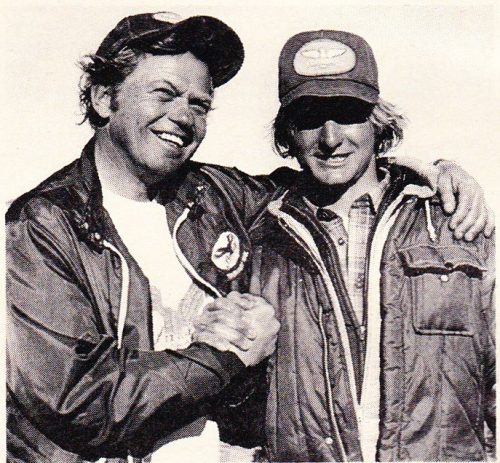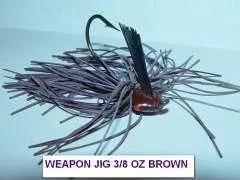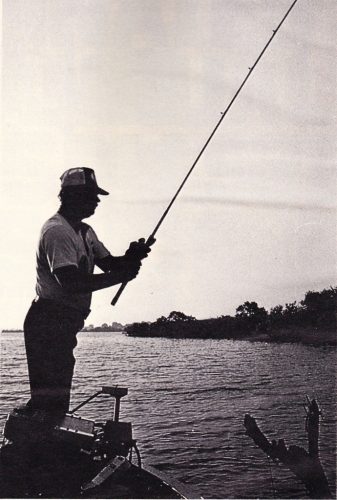Throwback Thursday – FLIPPIN’: A CONCEPT. NOT JUST A TECHNIQUE – PART TWO
By Terry Battisti – Bass Fishing Archives
This is part two of a three-part series on the concept of flipping and the effect it had on the sport. In this installment, we talked with Gary Klein and Basil Bacon about their involvement with the early years of the technique. To read part one, click here.

In part one of this piece, Dave Myers talked about the three factors that came together to form the concept of Flippin’. He also talked about how an angler could thoroughly pick apart a shoreline in half the time it’d take an angler using conventional methods.
For parts two and three, I had the pleasure of interviewing four other anglers who took the ground rules, developed by Thomas, and added considerably to its foundation. Gary Klein, Hank Parker, Basil Bacon, and Denny Brauer all played pivotal roles in the progression of flipping and the way anglers approach shallow targets today.
These four anglers not only helped flipping progress, but they also helped design new equipment, terminal tackle, and baits to increase the effectiveness of the technique.
GARY KLEIN
When you think about the anglers who were there when flipping was invented – Thomas, Hauck, Gliebe, and Myers – if you leave out Gary Klein, you’ve left out one important part of the puzzle.
Klein, still a high school student and working at Lake Oroville in northern California, was making a name for himself fishing the Western Bass circuit. He and Thomas became fast friends, Thomas taking him under his wing.
“I was fortunate to meet Dee at a young age,” he said. “In the beginning, it wasn’t like Dee handed me things. He was smart in only giving me enough information so I had to go and do my homework. He was really smart about that – he made me work for it – and I appreciate it to this day.
“To be a part of the technique since its inception and watching it evolve has been an important part of my career. It’s because of this single technique that I decided to leave California and try to make a career fishing the B.A.S.S. circuit.
“Flipping wasn’t just a new technique – it was a new philosophy,” he said. “It was about how to catch a certain type of fish that’s relating to cover. To sum it up, the technique is just a way to present a lure in shallow water. But it also teaches you to learn patterns within patterns. For example, when I see a log in the water, I don’t just see a log – I see where it enters the water, each individual branch, where the sun is casting shadows, etc. I don’t just cast to a bush. Flipping has taught us to analyze more about what’s going on with respect to cover than any other technique. It made us a lot more efficient.
“Anglers today confuse flipping with pitching,” he said. “Flipping is NOT pitching. To me the flipping technique is all about having the line in your hand and swinging the bait. It’s more efficient and much more precise. If I’m pitching, I can miss fish [miss as in not placing the bait near them]. When I’m flipping, I won’t miss them.
“I said before that Flipping was the number one reason I left California. It wasn’t that I thought I wasn’t as good as the stars of the time – anglers like Roland, Dance, Tommy [Martin] – I just knew that with a Flip Stik in my hand, I was better than any of the other anglers with that type of fish.
“Dee and Dave [Gliebe] had already gotten the word out but the media was slow to cover it. By ’79 when I came out, there was still virtually no one doing it or anyone who really understood it. No one had a Flip Stik in their boat. That’s what gave me the mentality that I could do better against the others.
“When I came out east, I brought seven rods with me – all Flip Stiks,” he said. “I knew I could compete and in my first year on the B.A.S.S. circuit, I finished 10th, 1st, 6th, 26th, 18th and 7th. I missed Angler of the Year in the last event to Roland [Martin] by a little over a pound. Eighty-percent of the fish I caught that year were caught flipping.”
Klein wasn’t just one of the first anglers to utilize flipping on the national circuits, either. He was also a tackle developer with close friend Rich Forhan.
“In the first years when I came on the circuit, my number-one bait was a black 6-inch lizard,” he said. “Over the years, though, I’ve flipped everything.
“Then Rich Forhan and I got together to design a jig. The Weapon Jig and hook evolved because Rich was trying to get the best equipment in my hands.

“We found the original hook through Herters,” he said. “It was a round-bend needle-point hook design, completely contrary to what was popular back then, made by Partridge of England. When I was 18 years old, I met with the owner of Eagle Claw and tried to talk him into making it for us. He didn’t want to do it. So we bought our hooks from Herters.
“The jig head came from a lot of testing. We wanted the head to slide out of the fish’s mouth easily in order for better hookups. We fashioned a number of head shapes out of steel and tested them. What we came up with, coupled with the flat hook eye, was the result.
“A while into making the jigs, we found out that Herters was going to discontinue selling them so we bought all they had left. That’s when Rich went over to England and met with Partridge. That’s when they came up with the black Weapon flipping hook made out of Sheffield steel.
“Mustad later bought the company and they came out with the Ultra Point hook. It’s because of this single technique that we have round needle-point hooks. The hook companies were forced to make them because of flipping. In 1979 when I lost Angler of the Year to Roland, it was because I lost fish due to the wrong hook.
“Another thing that happened right off the bat was the flipping switch,” he said. “Basil Bacon gets the credit for that. In fact he used to work on all my reels in his garage back when we used to hang out together.
“Still today I won’t fish a reel without a flipping switch. In fact, because of me, Zebco still makes a reel model with one on it – and they kid me about it all the time.
“Now we’re seeing all sorts of different tools, maybe not designed for flipping but have made it much more efficient. Tungsten weights, punch skirts and braid have all had an effect on flipping.”
Although Klein is one of the most decorated anglers in the sport, he still hasn’t forgotten his roots.
“I’ll always be indebted to Dee because he let me get close to him and Dave [Gliebe]. He and flipping are why I was so successful. Dee has never received the credit he deserves.”
BASIL BACON
Another angler who was there almost from the start was Basil Bacon. Although Bacon wasn’t from California, he was lucky enough to have competed in the Bull Shoals event in ’75 – the event that Thomas won and put flipping on the map.

“I met Dee at the Bull Shoals event,” he said. “Dee didn’t come back much after that but [Dave] Gliebe did and that’s how I got to know Dave.
“Gliebe and I ended up at a PSI (Project Sports Inc.) event on Rend Lake in Illinois. There was a small grocery store in town and they had an attic above it where they sold beds for the night. Dave and I each rented a bed and that’s where we got acquainted.
“We’d been talking about flipping but nothing came of it.
“The first day of the tournament I did pretty well and was close to the leader. The second day I didn’t do too well and on the third day, I couldn’t even catch a fish. Dave came in with a sack and I think he won it.
“After that, we headed to Lake Cordell Hull in Tennessee. Before we left I asked him about the long pole and that I’d like to spend some time with him and learn about it.
“During practice, we had a thunderstorm roll through and we couldn’t fish. After it cleared I asked him to show me how to flip. He pulled the boat into the back of a cove and flipped this bog ole’ jig into some grass growing on the bank. I’m not talking emergent vegetation, I’m talking lawn-type grass on the shore that was flooded.
“He shook the jig a little and then flipped a 3-pounder in the boat. He ruined me.
“He showed me just enough to get me in trouble and it took me a year to figure out all the mechanics of it. Of course, I developed a lot of my own techniques during that time – as I still do.
“Until ’79 I had flipping all to myself in this part of the world,” he said. “Then at the Classic in ’79, Hank Parker, who didn’t know what flipping or a flipping stick was, got on it and won.
“Flipping was almost 100% of my fishing once I learned how to do it,” he said. “I lived with the theory of how fish position themselves on structure. Current, wind current, no wind, the shade, time of day – all that stuff. A lot of people would come up to a piece of cover and just throw at it. Then maybe they’d get closer and flip it.
“That wasn’t my approach at all. What I’d do is look the cover over, taking all the conditions into account, and then decide how and where I wanted to place my first flip. There was nothing haphazard about what I did. The first flip was the most important.”
Bacon wasn’t just a learner when it came to flipping, he was an innovator.
“Back when Dee and Dave [Myers] were coming back east, Dave showed me how to take the free spool release springs out of an Ambassadeur to make it a flipping reel,” he said. “After that, I’d do the same but always thought there was a better way.
“Gary Klein was following me all over the country at the time and we came to my house here in Springfield [MO]. We were talking and I said, ‘There are too many times we’re flipping and we want the reel to be a casting reel. Wouldn’t it be nice to have a switch on the reel so it could do both?’ He thought it was a good idea too.
“I got a hold of a Langley, an Ambassadeur and a Diawa Millionaire, took them apart and made the parts for a flipping switch for each of them. The Ambassadeur was the best of the bunch.
“I took the reel to Johnny Morris – we’ve been friends since before he opened Bass Pro Shops – and it tripped his trigger. We worked out a deal that we could share and then we went to Ambassadeur (ABU) with it. They were the first to pick up on it in ‘80-‘81. We never patented the idea but sold it to ABU.”
Bacon not only invented the flipping switch, he also had his hands in the development of baits.
“The jigs I used back then were primarily Gary’s Weapon Jig,” he said. “There were a couple of things I thought could be improved on it so I went to a friend, Al Dunning, who had been bugging me to design a jig for him. We designed the jig and it became the Basil Bacon Super Jig manufactured by Al-Ron Lures.
“The jig was designed to come through wood, specifically wood here on Truman Reservoir,” he said. “The thing about Truman wood is one year the lake froze and then dropped two feet while still frozen. When that happened, the trees broke in a downward fashion at it was tough to get a jig through. The design of my jig helped an angler get through it. Every angler who came to fish the lake would by my jigs because they worked.
“In the early days I primarily flipped the jig,” he said. “Then after Hank [Parker] won the Classic in 79, I started using plastics. I won a couple of tournaments using lizards and worms and then developed a bait called the Bacon Rind – one of the first creature baits.

“What drove me to that was the fact I didn’t like to flip tubes because I liked to fish deeper in the trash and the old tubes hung up a lot. The bait was designed like a tube but was solid and had tails and flappers. I’d take and rip the back tails off the bait and it fished just like a tube on the fall. It allowed me to fish heavier cover without getting hung up.”
Bacon feels today’s anglers are confused about what the technique really is.
“Most anglers today pitch instead of flip and that’s been one of the big misconceptions since the beginning. When I first started flipping, an angler by the name of Bill Ward came to me to talk about it. I showed him what I was doing and he said, ‘I do that with a spinning rig.’ What he was actually doing was pitching with a spinning rod.
“An angler who flips has more control than an angler pitching. That’s what is so critical about the technique. You have control of where the lure is going, control of the lure when it’s in the cover and, most importantly, control over the fish once you hook him. Pitchers don’t have this kind of control of the entire situation.”
Overall flipping was a learning process,” he said. “It was very good to me over the course of my career. The only problem was I should have fished other baits and techniques more. I was a diehard with the flipping stick.”
In all Bacon has won 11 big events with the big stick and finished second in the ’79 Classic on Texoma flipping.
In part three of this series, we’ll be talking with Hank Parker and Denny Brauer and how flipping helped their careers.
If we’ve piqued your interest and you’d like to read ahead, check out the rest of the story at Bass Fishing Archives with the link below:























